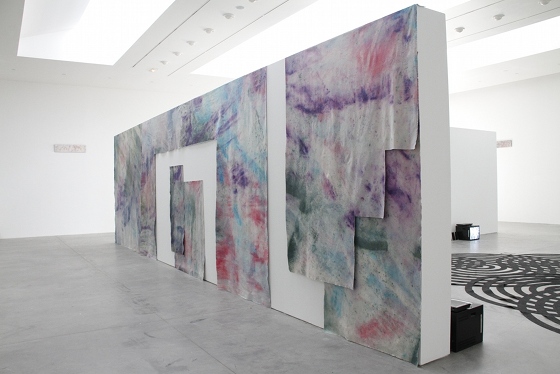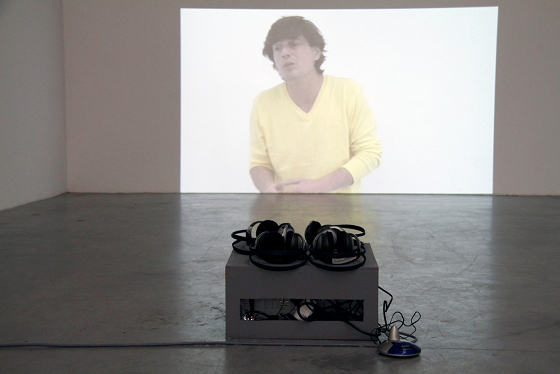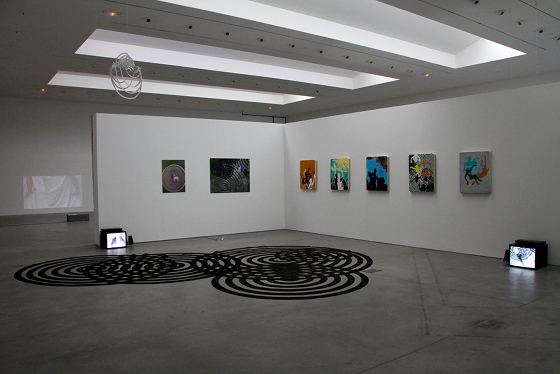
Cl : Vaïda Budreviciuté - © Frac des Pays de la Loire

Cl : Vaïda Budreviciuté - © Frac des Pays de la Loire

Cl : Vaïda Budreviciuté - © Frac des Pays de la Loire
XXIVe ateliers internationaux
du Frac des Pays de la Loire
Artiste : Scoli Acosta, Élise Florenty , Loreto Martinez Troncoso , Stéphane Querrec, Clément Rodzielski, Jessica Warboys
curated by Émilie Renard
Residency : September 20th - November 28th 2010
The residency brings six artists together for a two-month period, at the end of which there is an exhibition accompanied by a catalogue. As the sole prior condition for the residency, I am assuming that the exhibition catalogue has already been written, read, published, translated and commented upon, and that it is Virginia Woolf’s book The Waves, written in 1931. For this purpose, the essential information (artists, dates, location) will be mentioned on the first page of the book.
This book is constructed like a transition sequence of six inner monologues without any transition, in the first person, whose continuous flow is interrupted on nine occasions by brief interludes: nine descriptions of a coastal landscape, from dawn to dusk, in the third person. The six characters in the novel – Bernard, Susan, Rhoda, Neville, Jinny and Louis – are linked since childhood, and the book follows their soliloquies until their death. Each voice is distinctive yet they form, all together, a kind of central consciousness, and depict the disorderly features of a single multiple personality. In her diary Woolf wrote that the six voices were not designed to be separate characters, but rather facets of consciousness shedding light on the sense of continuity. By shifting alternately in the ebb and flow of six streams of consciousness, and by showing mutual confusion and influence, Woolf explores the links between individuality and community.
This form of appropriation of a novel within the frame of an exhibition has several consequences. First, the exhibition takes its title from the novel: Les Vagues (The Waves). The situation of the fiction and that of the residency are also, in at least one way, similar, as they bring together six people, three men and three women, within a common circumstance (on the scale of a lifetime for the former and of a two-month residency for the latter). The catalogue will then be our shared horizon, which is tantamount to raising the issue of its adaptation. So this literary object will be the only discursive source on the exhibition and can act as a medium for interpretations and projections for the artists as for the audience. Positing the previous existence of a catalogue means testing its prescriptive and descriptive value, its capacity to anticipate an exhibition. For this catalogue which arrives in advance, also keeps, as such, its status of an interpretive object. Lastly, the nine coastal interludes which weave the metaphor of a lifetime scaled down to a day will be an area of my curatorial investigations, conceived as in a neutral,
exterior and descriptive perspective, which is more contemplative than interventionist. This residency bringing together with very different artists thus proposes, with this book as a catalogue, almost in spite of them, a meta-narrative.
This book represents neither a manual nor a guide, and its relation to the residency and the exhibition is, for the time being, merely theoretical and metaphorical, and still has to be discussed, interpreted and possibly kept at distance. In more concrete terms, perhaps, it is therefore still necessary to see how these six albeit different artists share the task of broaching, in one way or another, the issues of narrative identity, confusion between oneself and another, identification and personification, alienation and loss of identity, with as many possible back-and-forth shifts between ambivalent postures of sincerity and insincerity.
(This note was also the invitation letter send by Émilie Renard to the artists.)